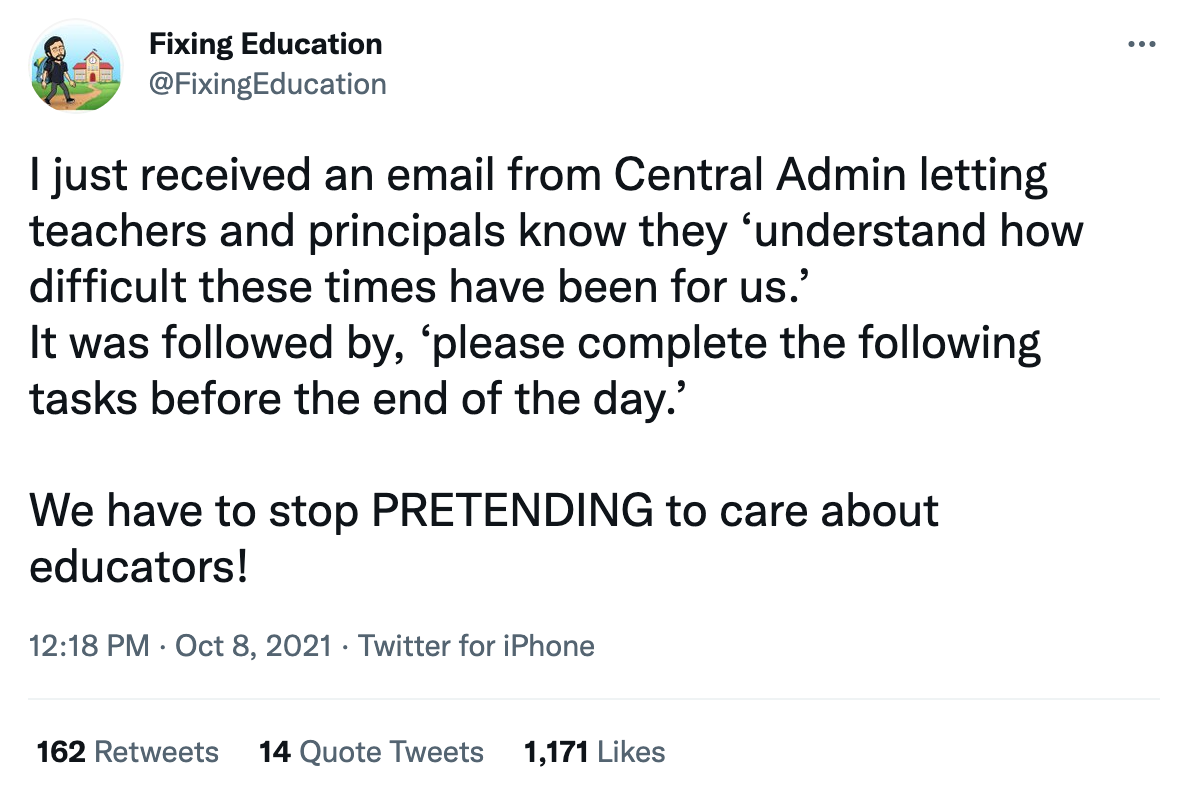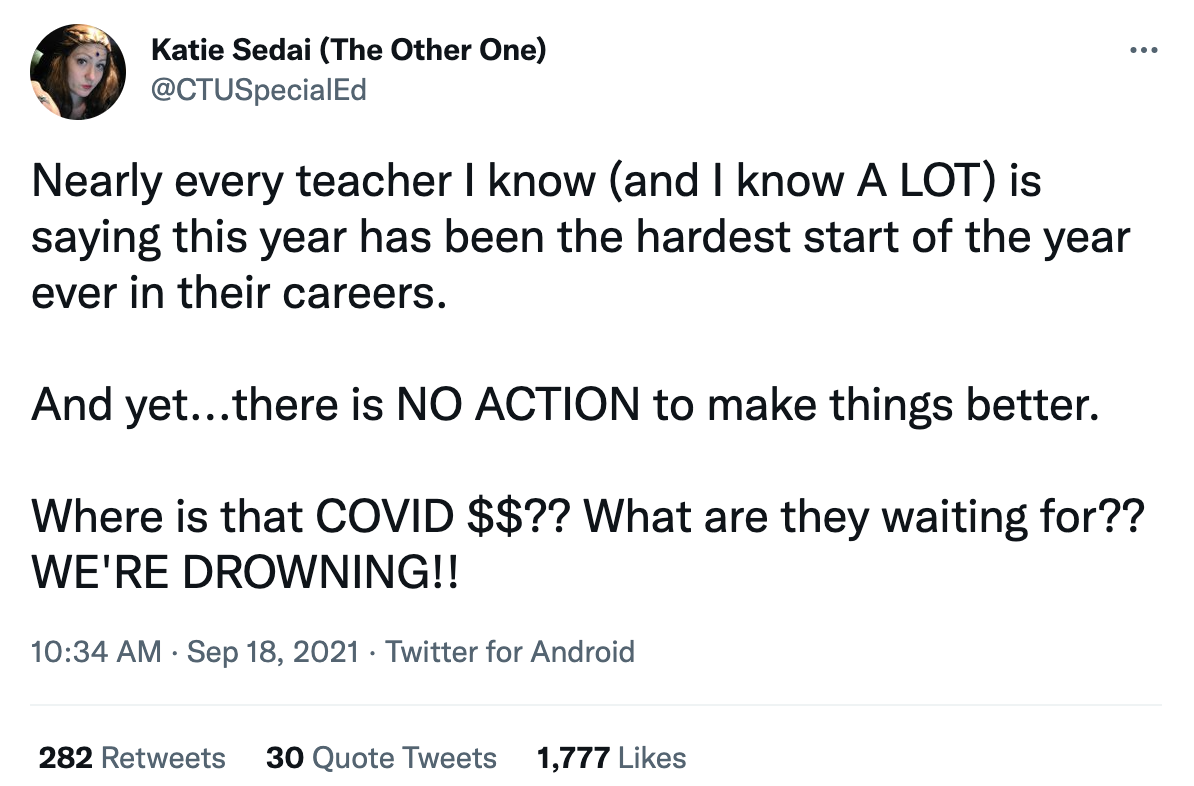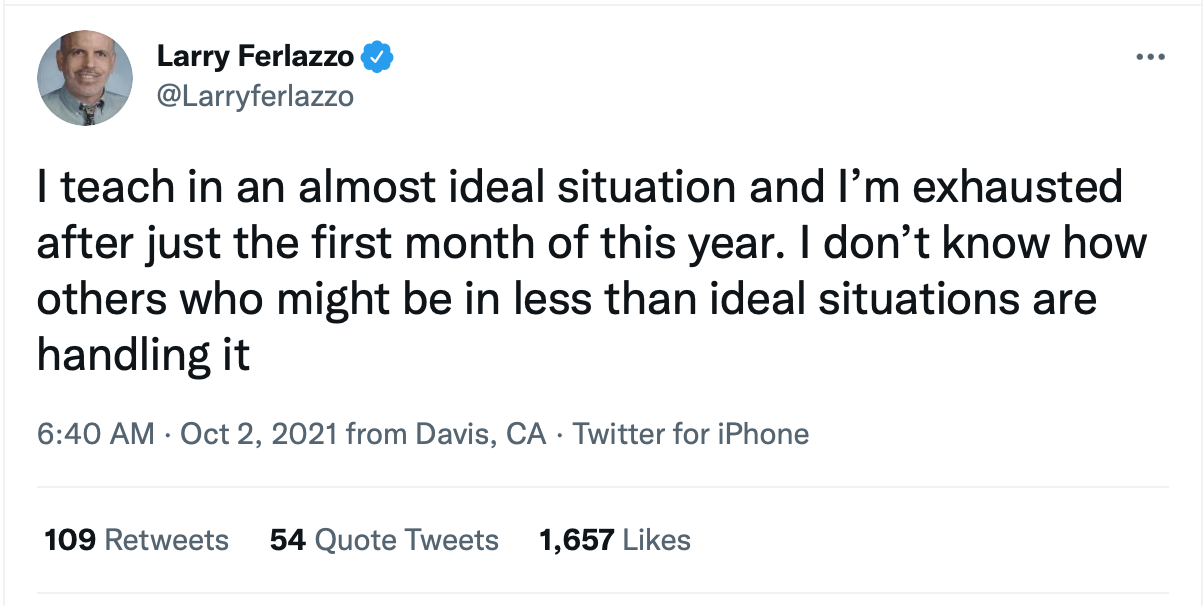Answer Sheet: Teacher: 10 Things School Districts Should Do Right Now
The 2021-22 school year is still young, but with the coronavirus pandemic still affecting teaching and learning, many teachers say they are already exhausted and overwhelmed.
In the following piece, a veteran teacher offers 10 actions that school districts can take now to support teachers and students.
The author is Larry Ferlazzo, who has taught English and social studies at Luther Burbank High School in Sacramento for the past 18 years. He has written or edited 12 books on education and is about to publish his 13th; writes a teacher advice blog for Education Week; and writes a popular resource-sharing blog.
By Larry Ferlazzo
After nearly two years of living and working in a pandemic, many people are not doing very well. That includes teachers — and it’s only two months into the school year, with eight more to go.
I recently sent out this tweet, which says: “I teach in an almost ideal situation and I’m exhausted after just the first month of this year. I don’t know how others who might be in less than ideal situations are handing it.”
As you can see, it received nearly 2,000 “likes,” not to mention scores of almost desperate replies.
The reasons for these situations vary. Some teachers are:
- dealing with the stress of potentially getting covid-19 and transmitting it to a loved one in schools where there are no mask mandates;
- coping with the challenge of a substitute shortage requiring teachers to give up all their planning time (or to teach double classes) to cover absences;
- having to cancel medical appointments and mental health days because of not wanting to burden colleagues by making them cover even more classes;
- working in dysfunctional districts that don’t value teacher voice and feel like things should “get back to normal”;
- being overtaxed by providing even more than the usual emotional support we provide to our students.
There is also the strain on all of our “mental bandwidths” with the personal stress of living through a pandemic, and the added challenges facing teachers with children at home.
There are actions that districts can take to help teachers and their students successfully make it through the year (remember, as the saying goes, “Teacher working conditions are student learning conditions.”).
Though I think all of the following ideas are doable, I would suggest that the pandemic has made the lack of skilled leadership in many school districts transparent, and I am not confident that all of then have learned critical lessons along the way. Districts are bureaucracies, which are not usually known for their nimbleness, and some are not known for their competence.
Though many teachers have extensive experience shielding students from the consequences of unwise district decisions, the pandemic has overwhelmed that capacity. So here are 10 ideas that school districts could do — if they want — to help make the school successful:
- Implement student mask mandates if there aren’t ones already. Yes, in some situations, there are state laws prohibiting such measures. But that hasn’t stopped courageous districts from doing them, anyway. In addition to increasing teacher and student safety, mandates would likely reduce the number of students (and teachers) who are quarantined, and the resulting added workload.
- As our local union has proposed, hire a full-time dedicated crew of people to work as substitutes. Yes, I understand that hiring can be a challenge, but what if the job was paired with a training/internship program that would lead to a teaching credential? Might that not make it a lot more enticing, especially to the many people who have used this pandemic to reassess their career goals?
- In the interim, triple the hourly rate teachers are compensated for covering another class during their planning period. It won’t gain back our planning time, but it could make the experience feel less painful.
- Except in highly unusual circumstances, suspend ALL professional development for the year. Teachers need that time for planning (especially since our planning times are being taken up with covering for absent colleagues), assessing student work, and just plain resting.
- Recognize that things are not “back to normal.” For example, after suspending a required major Senior Project as a graduation requirement last year, our school board just reinstituted it. Do teachers and our students really need that kind of pressure in the middle of a pandemic?
- For heaven’s sake, don’t unveil any new “initiatives”!
- Eliminate all district assessments this year. Most are generally pretty useless to teachers during normal times and, for sure, this year we won’t be paying much attention to them.
- This one isn’t within a district’s control, but they can at least ask states to request that the federal government not require standardized testing this school year. None of us need even more disruption, and reduced instructional time.
- Support educators who are teaching about anti-racism and other social justice issues, instead of undercutting us. Show some spine and don’t give in to critical race theory hysteria.
- Look for ways to acknowledge teachers’ value (some educators on Twitter said their district had given them continuing education credits for what they learned about education technology last year). Work with educators (through their unions where there are ones) in implementing the principle of subsidiarity — that the people closest to the problems generally have a pretty good idea about how to solve them. Raising teacher pay, and certainly not reducing it (as our district is proposing through increasing employee health-care costs), would help, too.
I’m sure there are plenty of other good ideas out there about what districts could do to support teachers, and I would love to learn about them in the comments section.
I’m also sure that not an insignificant number of district leaders need to get their heads out of the sand and understand that they are facing an emergency in teacher morale and well-being. Some may think something like, “Jeez, I’m barely keeping my head above water now with the pandemic crises affecting our district and now the teachers are complaining about their needs, too. I just don’t have time or energy for it.”
Well, when our students are facing crises, those of us in the classroom don’t really have the luxury of ignoring them — for moral reasons and because we recognize the fact that our students’ well-being has a critical effect on everything else we want (and are supposed) to do professionally.
If leaders don’t take action, teachers may or may not leave the profession, but many are likely to begin (and, in fact, have begun already) moving to districts that do take their concerns seriously.
District leaders, it’s time to reprioritize ….
This blog post has been shared by permission from the author.
Readers wishing to comment on the content are encouraged to do so via the link to the original post.
Find the original post here:
The views expressed by the blogger are not necessarily those of NEPC.




